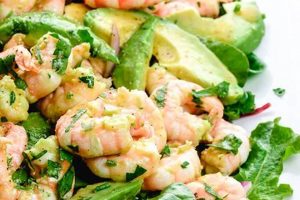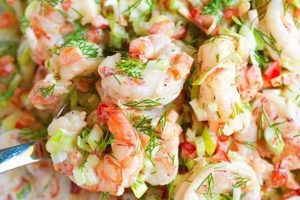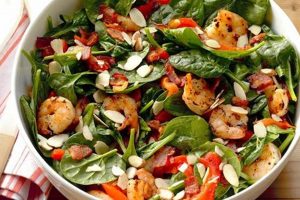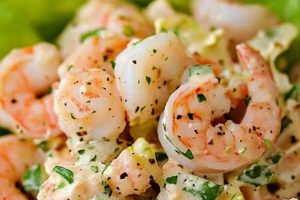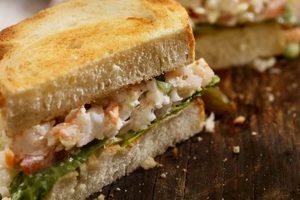A dish combining cooked shrimp with the typical elements of a taco such as seasoned vegetables, cheese, salsa, and sour cream or a creamy dressing served atop a bed of crisp lettuce or tortilla chips forms the core concept of this culinary creation. Variations may include different types of beans, corn, avocado, or other desired toppings, offering a customizable and flavorful meal.
This meal offers a lighter alternative to traditional tacos while retaining the beloved flavors. Its versatility makes it suitable for various occasions, from casual weeknight dinners to festive gatherings. The customizable nature allows for dietary adaptations, such as substituting ingredients to accommodate gluten-free or low-carb preferences. The combination of fresh ingredients with flavorful seasonings creates a balanced and satisfying dish, rich in protein and nutrients.
The following sections will explore various aspects of preparing this dish, including selecting the freshest ingredients, mastering different cooking methods for the shrimp, creating flavorful homemade dressings and salsas, and offering suggestions for presentation and serving.
Tips for a Delicious Shrimp Taco Salad
Achieving a truly exceptional salad involves attention to detail and thoughtful preparation. These tips offer guidance for elevating this dish from simple to outstanding.
Tip 1: Shrimp Selection and Preparation: Opting for high-quality, fresh or properly frozen shrimp is crucial. Thawing should be done gently in the refrigerator to maintain texture. Overcooked shrimp becomes rubbery; brief, high-heat cooking is recommended.
Tip 2: Seasoning Strategies: Marinating the shrimp prior to cooking infuses deeper flavor. Spice blends specifically designed for tacos or fajitas work well, or custom blends can be created using chili powder, cumin, paprika, and garlic powder.
Tip 3: Building a Flavorful Base: The foundation of the salad influences the overall taste. Consider using a mix of crisp romaine lettuce and shredded cabbage for texture and flavor. Adding a layer of crushed tortilla chips enhances the crunch.
Tip 4: Dressing and Salsa Selection: A creamy cilantro-lime dressing complements the shrimp and vegetables beautifully. Alternatively, a vibrant pico de gallo or a smoky chipotle salsa adds a kick. Balancing creamy and spicy elements is key.
Tip 5: Enhancing with Toppings: Avocado slices provide creaminess and healthy fats. Black beans or corn introduce contrasting textures and sweetness. A sprinkle of crumbled cotija cheese adds a salty, tangy finish.
Tip 6: Achieving Optimal Crispness: To prevent a soggy salad, keep the components separate until just before serving. Toss the dressing with the shrimp and vegetables, then arrange them over the lettuce and chips.
Tip 7: Presentation Matters: Consider serving the salad in individual bowls or on large platters for sharing. Garnishing with fresh cilantro sprigs, lime wedges, and a dollop of sour cream or guacamole enhances visual appeal.
By following these suggestions, one can create a visually appealing and flavorful salad that satisfies even the most discerning palate.
The following section will offer concluding thoughts and variations for customizing this versatile dish.
1. Fresh, High-Quality Shrimp
The foundation of a successful shrimp taco salad rests upon the quality of its central ingredient: shrimp. Fresh, high-quality shrimp contributes significantly to the overall flavor, texture, and aroma of the dish. Using inferior shrimp can result in a rubbery texture and a bland, sometimes fishy, taste, detracting from the desired outcome. Conversely, fresh shrimp offers a succulent, slightly sweet flavor and a firm, yet tender texture, enhancing the culinary experience.
The impact of shrimp quality becomes particularly evident when considering cooking methods. Fresh shrimp cooks quickly and evenly, absorbing marinades and seasonings effectively. Overcooked, low-quality shrimp often becomes tough and loses its delicate flavor. For instance, a salad featuring plump, juicy shrimp, lightly seasoned and grilled, provides a stark contrast to one made with pre-cooked, frozen shrimp lacking both flavor and texture. In a taste test, the difference is immediately discernible; the fresh shrimp offers a clean, bright flavor, while the lower-quality shrimp might present a lingering aftertaste. This difference underscores the importance of prioritizing fresh ingredients.
Selecting fresh, high-quality shrimp necessitates careful consideration. Consumers should look for shrimp that is firm, translucent, and smells of the sea. Avoid shrimp with a strong fishy odor or a slimy texture. Sourcing shrimp from reputable suppliers committed to sustainable fishing practices further ensures a superior product while supporting responsible aquaculture. Ultimately, the investment in high-quality shrimp directly translates to a more enjoyable and flavorful dining experience.
2. Crispy tortilla chips
Crispy tortilla chips contribute significantly to the textural complexity of a shrimp taco salad. Their presence offers a satisfying contrast to the softer elements of the dish, such as the shrimp, lettuce, and other toppings. This contrast elevates the eating experience, transforming a simple salad into a multi-dimensional culinary creation. Without the chips, the salad might feel one-dimensional, lacking a crucial textural counterpoint. Consider a taco salad comprised solely of shrimp, lettuce, and dressing; the overall mouthfeel would be predominantly soft. The introduction of crispy tortilla chips immediately introduces a welcome crunch, enhancing the enjoyment of each bite.
Furthermore, the structural integrity provided by tortilla chips is essential. They act as a foundation, preventing the salad from becoming overly soggy from the dressing and other moist ingredients. This is particularly crucial when the salad is not consumed immediately. Imagine a scenario where a taco salad is prepared in advance for a picnic or potluck. Without the chips, the lettuce would likely wilt and become saturated with the dressing by the time it is served. The chips, however, provide a barrier, maintaining a degree of crispness and preventing the salad from becoming a watery mess. This structural role is vital for situations requiring advance preparation or transport.
In summary, the inclusion of crispy tortilla chips in a shrimp taco salad is not merely an optional addition; it is a vital component that significantly impacts the overall culinary experience. The textural contrast and structural support they provide elevate the dish, offering a more satisfying and enjoyable meal. Understanding the crucial role played by tortilla chips allows for more informed recipe development and execution, ensuring a consistently successful and flavorful outcome.
3. Flavorful Taco Seasoning
Flavorful taco seasoning plays a pivotal role in a successful shrimp taco salad recipe, acting as the primary flavor vector for the shrimp itself. It elevates the inherent sweetness of the shrimp, introducing complexity and depth. The careful selection and application of seasoning can transform otherwise bland shrimp into a culinary centerpiece, driving the overall flavor profile of the entire salad.
- Spice Complexity:
A well-rounded taco seasoning blend typically incorporates a combination of spices like chili powder, cumin, paprika, garlic powder, onion powder, and oregano. The interplay of these spices creates a complex flavor profile that complements the shrimp. For instance, the earthiness of cumin, combined with the smokiness of paprika and the warmth of chili powder, builds a layered flavor foundation. This complexity prevents the seasoning from being one-dimensional, allowing for a more nuanced and satisfying taste experience within the context of the salad.
- Heat Level:
The level of heat within the taco seasoning contributes significantly to the overall sensory experience of the salad. The amount of cayenne pepper or other chili-based spices dictates the spiciness. A mild seasoning allows the delicate sweetness of the shrimp to shine, while a spicier blend adds a fiery kick that can contrast beautifully with the cool, creamy elements of the salad. Balancing the heat level according to personal preference is essential for achieving a harmonious flavor profile.
- Balancing Salt and Acidity:
Salt is a crucial component of taco seasoning, enhancing the other flavors and drawing out the natural juices of the shrimp. However, excessive salt can overpower the delicate flavor balance. Similarly, incorporating a touch of acidity, often through the addition of citric acid or a small amount of lime zest in the seasoning blend, brightens the overall flavor profile. This balance of salt and acidity prevents the seasoning from being overly salty or flat, contributing to a well-rounded taste.
- Application Technique:
The method of applying the taco seasoning to the shrimp also influences the final outcome. Marinating the shrimp in the seasoning blend allows for deeper flavor penetration, resulting in a more pronounced taste. Alternatively, coating the shrimp just before cooking creates a flavorful crust. The chosen technique impacts the intensity and distribution of the seasoning, impacting the overall flavor experience within the salad.
By understanding the multifaceted nature of taco seasoning and its impact on shrimp, one can elevate a shrimp taco salad from a simple dish to a carefully crafted culinary experience. The nuanced interplay of spice complexity, heat level, balanced salt and acidity, and application technique all contribute to the final flavor profile, ultimately determining the success of the dish.
4. Vibrant Vegetable Mix
A vibrant vegetable mix constitutes an essential component of a successful shrimp taco salad, contributing not only crucial nutrients but also textural and flavor complexity. This mix typically comprises a variety of fresh vegetables selected to complement the shrimp and other ingredients. Its presence elevates the salad from a protein-centric dish to a balanced and flavorful meal.
- Color and Visual Appeal
The inclusion of colorful vegetables significantly enhances the visual appeal of the salad. Bright reds from tomatoes and bell peppers, deep greens from lettuce and cilantro, and vibrant yellows from corn create an aesthetically pleasing presentation. This visual appeal stimulates appetite and contributes to a more enjoyable dining experience. A monochromatic salad, lacking this visual diversity, might appear less appetizing despite having similar flavor profiles.
- Textural Contrast
Different vegetables offer varied textures, creating a more dynamic and engaging mouthfeel. The crispness of romaine lettuce, the crunch of bell peppers, the juiciness of tomatoes, and the slight chewiness of corn kernels provide textural counterpoints to the tender shrimp and crispy tortilla chips. This interplay of textures elevates the eating experience beyond a simple combination of flavors.
- Flavor Complexity
Each vegetable within the mix contributes its unique flavor profile, adding depth and complexity to the overall taste of the salad. The sweetness of corn, the tanginess of tomatoes, the slight bitterness of lettuce, and the herbaceous notes of cilantro create a layered flavor profile that complements the savory shrimp and the spices in the taco seasoning. This complexity prevents the salad from tasting one-dimensional, enhancing its appeal.
- Nutritional Value
Beyond flavor and texture, the vegetable mix contributes essential vitamins, minerals, and fiber to the salad, transforming it into a nutritionally balanced meal. This nutritional boost aligns with health-conscious eating habits, offering a satisfying and nutritious alternative to less healthy options. The inclusion of a variety of vegetables ensures a wider range of nutrients, maximizing the health benefits of the meal.
The carefully considered combination of color, texture, flavor, and nutritional value offered by a vibrant vegetable mix elevates the shrimp taco salad from a simple dish to a well-rounded and satisfying culinary experience. This mix provides a crucial bridge between the primary protein source and the other components, resulting in a balanced and flavorful meal.
5. Creamy, Zesty Dressing
Creamy, zesty dressings play a crucial role in shrimp taco salads, providing a unifying element that binds the diverse components into a cohesive whole. The creaminess of the dressing coats the ingredients, creating a smooth mouthfeel and distributing flavor evenly throughout the salad. This creamy element also tempers the potential sharpness of the spices in the taco seasoning, creating a balanced flavor profile. The zesty component, often derived from citrus juices like lime or lemon, adds a refreshing brightness that cuts through the richness of the shrimp and the creamy dressing. This interplay of creamy and zesty elements creates a complex flavor dynamic that elevates the salad beyond a mere assemblage of ingredients. For example, a creamy cilantro-lime dressing provides a refreshing counterpoint to the spiciness of the seasoned shrimp and the richness of avocado, while simultaneously enhancing the sweetness of the corn and the freshness of the tomatoes. Without such a dressing, these individual components might clash, resulting in a disjointed and less satisfying flavor experience.
The practical significance of understanding the role of the dressing becomes evident when considering recipe variations. Different dressings can drastically alter the overall character of the salad. A chipotle-ranch dressing, for example, introduces a smoky element, while a lighter vinaigrette offers a brighter, more acidic profile. Choosing the right dressing requires careful consideration of the other ingredients and the desired flavor outcome. Furthermore, the consistency of the dressing affects how well it clings to the salad components. A thinner dressing might pool at the bottom, leaving the other ingredients relatively dry, whereas a thicker dressing provides better coverage and flavor distribution. A practical application of this understanding might involve adjusting the dressing’s consistency based on the specific ingredients used. A salad with heavier ingredients, like black beans, might benefit from a thicker dressing, while a lighter salad might require a thinner one.
In summary, the creamy, zesty dressing serves as more than just a condiment in a shrimp taco salad; it is an integral component that contributes significantly to the overall flavor, texture, and balance of the dish. Understanding the nuanced interplay between the creamy and zesty elements, as well as the practical considerations of dressing selection and consistency, is essential for crafting a truly exceptional shrimp taco salad. This understanding allows for informed decision-making in recipe development and adaptation, ensuring a consistently delicious and satisfying culinary outcome.
6. Assortment of Toppings
The assortment of toppings constitutes a defining characteristic of the shrimp taco salad, offering a platform for personalization and contributing significantly to the overall flavor, texture, and visual appeal. Strategic topping selection allows for customization based on individual preferences and dietary needs while enhancing the salad’s sensory experience.
- Flavor Enhancement
Toppings provide an opportunity to introduce additional flavor dimensions, complementing the existing components. Shredded cheese adds a salty, savory element, while diced avocado contributes a creamy richness. A dollop of sour cream or Greek yogurt introduces tanginess, and a sprinkle of chopped cilantro or chives offers a fresh, herbaceous note. Consider the interplay between a spicy shrimp base and a cooling avocado topping, or the contrast of a tangy salsa with a creamy cheese. These flavor combinations elevate the salad beyond a simple sum of its parts.
- Textural Variation
Toppings introduce varied textures, creating a more engaging mouthfeel. Chopped nuts or seeds add a satisfying crunch, while crumbled cheese offers a pleasant chewiness. Sliced or diced fruits, such as mango or pineapple, provide a juicy burst, and pickled onions or jalapeos introduce a crisp acidity. The combination of crunchy tortilla chips, tender shrimp, and a variety of toppings transforms each bite into a multi-textural experience.
- Visual Appeal
A thoughtfully arranged assortment of toppings enhances the visual appeal of the salad, making it more enticing. Brightly colored ingredients, such as diced bell peppers, chopped tomatoes, or shredded carrots, add vibrancy. Strategic placement of toppings, such as a sprinkle of fresh herbs or a drizzle of a contrasting sauce, adds visual interest. This aesthetic enhancement contributes to the overall dining experience, making the salad more appealing to the eye.
- Nutritional Enrichment
Toppings offer an opportunity to boost the nutritional value of the salad. Nutrient-rich options, such as black beans, corn, or chopped vegetables, increase the fiber, vitamin, and mineral content. Seeds and nuts provide healthy fats and protein. Consider adding a sprinkle of chia seeds for omega-3 fatty acids or a handful of chopped walnuts for antioxidants. These additions transform the salad into a more complete and nutritious meal.
The strategic selection and application of toppings elevate the shrimp taco salad from a basic dish to a customizable culinary creation. The interplay of flavor, texture, visual appeal, and nutritional value offered by the toppings contributes significantly to the overall enjoyment and satisfaction derived from this versatile and flavorful meal.
7. Proper Assembly Technique
Proper assembly technique is crucial for a successful shrimp taco salad, directly impacting the final taste, texture, and overall enjoyment. A well-assembled salad maintains the integrity of individual components, preventing a soggy, unappetizing outcome. The order of layering ingredients significantly influences the final product. For instance, placing the tortilla chips at the bottom creates a foundation that prevents the dressing from saturating the lettuce. Distributing the shrimp and other toppings evenly ensures balanced flavor and texture in every bite. Conversely, improper assembly, such as adding the dressing directly to the lettuce or layering all the wet ingredients together, can lead to a soggy salad, diminishing the crispness of the chips and the freshness of the vegetables. Consider a scenario where the dressing is added to the entire salad at once. The lettuce will wilt quickly, the chips will become soggy, and the overall texture will be compromised. This demonstrates the direct cause-and-effect relationship between assembly technique and the final product’s quality.
The practical significance of proper assembly becomes particularly evident in scenarios involving make-ahead salads or large servings for gatherings. When preparing a shrimp taco salad in advance, layering is essential to maintain the desired textures. Placing a barrier, such as plastic wrap, between the dressing and the other ingredients further prevents premature sogginess. For large gatherings, assembling individual portions or creating a layered salad bar allows guests to customize their salads while ensuring optimal ingredient integrity. This approach addresses the challenge of maintaining freshness and crispness when serving a large group. Imagine a buffet-style setup where guests can select their desired toppings and add dressing just before serving. This strategy preserves the quality of the individual components and allows for personalized flavor combinations.
In conclusion, proper assembly technique is not merely a suggestion but a fundamental aspect of a successful shrimp taco salad recipe. The strategic layering of ingredients, coupled with an understanding of the potential pitfalls of improper assembly, ensures the preservation of flavors, textures, and overall quality. This practical understanding empowers individuals to create consistently delicious and visually appealing salads, maximizing enjoyment and culinary satisfaction, regardless of serving size or preparation timeline.
Frequently Asked Questions
This section addresses common inquiries regarding the preparation and enjoyment of shrimp taco salads.
Question 1: What is the best type of shrimp to use?
While personal preferences vary, medium-sized shrimp (41/50 count per pound) offer a balance of flavor and texture. Larger sizes can be used but may require adjustments to cooking time to prevent overcooking. Fresh, wild-caught shrimp is often favored for its flavor, but high-quality frozen shrimp can also produce excellent results if thawed properly.
Question 2: Can other proteins be substituted for shrimp?
Adaptability is a key advantage of this dish. Grilled chicken, fish (such as cod or mahi-mahi), or even plant-based protein alternatives can be substituted. Seasoning adjustments may be necessary to complement the chosen protein.
Question 3: How can sogginess be prevented?
Sogginess is a common concern. Keeping components separate until just before serving is crucial. Adding a layer of crushed tortilla chips to the bottom of the bowl or serving dish creates a barrier, preventing the dressing from directly contacting the lettuce. Serving the dressing on the side also allows individuals to control the amount added.
Question 4: What are some suitable dressing alternatives?
While creamy cilantro-lime dressing is a popular choice, other options exist. A vinaigrette, such as a lime-cumin vinaigrette, offers a lighter alternative. Avocado ranch dressing provides a richer, creamier texture. Spicy dressings, like chipotle ranch or sriracha mayo, add a kick.
Question 5: How can this recipe be adapted for specific dietary needs?
This dish offers significant adaptability. Gluten-free variations can be achieved by using corn tortillas or omitting the chips altogether. Low-carb options can be created by using a lettuce wrap instead of chips and limiting high-carbohydrate toppings like corn. Vegetarian versions can be achieved using plant-based protein substitutes.
Question 6: How long can leftovers be stored safely?
Proper storage is essential for food safety. Leftover shrimp taco salad should be stored in airtight containers in the refrigerator. Consuming leftovers within three to four days is recommended. Due to the varied components and the potential for sogginess, freezing is not generally recommended.
Addressing these common questions provides clarity and facilitates successful preparation of a delicious and satisfying shrimp taco salad. Understanding the nuances of ingredient selection, assembly, and storage ensures an optimal culinary experience.
The following section will provide a complete recipe with detailed instructions.
Shrimp Taco Salad Recipe
Exploration of the shrimp taco salad recipe reveals a dish offering nuanced flavor profiles and adaptable construction. Emphasis on fresh, high-quality ingredients, from succulent shrimp to crisp vegetables, contributes significantly to the overall culinary experience. Proper seasoning, a balanced dressing, and a considered selection of toppings further elevate this dish beyond a simple salad. Methodical assembly, prioritizing textural integrity and preventing sogginess, proves crucial for optimal enjoyment. Dietary adaptations, accommodating various preferences and restrictions, highlight the recipe’s versatility.
This exploration underscores the potential of the shrimp taco salad recipe as a canvas for culinary creativity. Careful consideration of each component, from the foundational protein to the finishing touches, allows for personalized interpretations and consistently satisfying results. This dish represents not merely a recipe, but an invitation to explore the interplay of flavors, textures, and culinary techniques.

